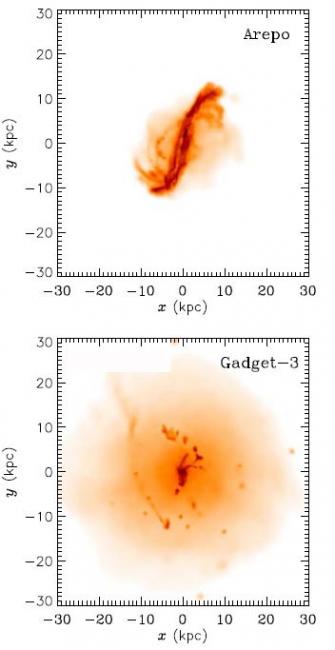
New computer codes are more accurately simulating what happens when galaxies merge to produce very luminous infrared galaxies. The figure compares the new code ("Arepo") compares with the older code ("Gadget-3"). Although the newer results appear to be more physically realistic and accurate, astronomers conclude that the previous models were not seriously in error in estimating effects of star formation.
The universe contains some galaxies more than a thousand times brighter than our own Milky Way galaxy. Many of them are practically invisible at optical wavelengths because the star formation that powers their emission is buried deep inside obscuring clouds of dust, but at infrared wavelengths the starlight-heated dust glows brightly. Galaxy collisions can enhance such star formation activity and produce these so-called infrared-luminous galaxies, but exactly what happens when galaxies merge and how they stimulate star formation is a subject that has been debated for at least fifty years since it was first hypothesized. Studying merging galaxies does more than sheds light on how galaxies evolve and form stars. Since they are so bright, they act as lanterns to cosmological epochs and their activity helps scientists study the early universe.
The general approach in studying mergers is to examine local examples to categorize their behaviors, and model these cases with computational codes that simulate the mergers. Twentieth century simulations included only the effects of gravity, but even so they provided valuable insights into the effects of mergers on galaxy morphologies, the formation of sweeping distortions seen as tidal tails and shells, and the kinematics of merger remnants. In the last few decades more sophisticated simulations have also included gas dynamical processes -- an important addition because the gas in galaxies constitutes a significant fraction of the mass, and unlike the stars, which are comparatively small and never collide, the gas can be heated, shocked or otherwise excited to dissipate energy. Modern merger simulations have also led to an improved understanding of the mechanisms that produce supermassive black holes at the galactic nucleus and that modify the galaxies' disks.
There are approximations used in the current simulations, largely because of a desire to reduce the time needed for a full computation. One such aspect of the most popular technique is to subdivide the mass in a galaxy into fixed-sized unit-cells to track the behavior of the gas, for example of dimensions about 150 light-years on a side. The problem is that any activity that takes place on a finer spatial scale might be inaccurately estimated. CfA astronomers Paul Torrey and Lars Hernquist and three colleagues have completed a study of mergers using a new simulation technique that among other things allows the dimensions and mass associated with a cell to change with time. In principle this should more accurately calculate the effects of shocks and other processes in the gas. Writing in the latest issue of Monthly Notices of the Royal Astronomical Society, the astronomers report that although the new code appears to work well and provide more precise and accurate results, the major conclusions from earlier studies about star formation and black hole growth are qualitatively verified. There are some quantitative differences of interest, but the overall result offers reassuring support for the earlier models, while being a step in the direction of even more precise calculations.
"Galaxy Mergers on a Moving Mesh: A Comparison with Smoothed Particle Hydrodynamics," Christopher C. Hayward, Paul Torrey, Volker Springel, Lars Hernquist, and Mark Vogelsberger, MNRAS 442, 1992, 2014.
Related News
CfA Celebrates 25 Years with the Chandra X-ray Observatory
The Radcliffe Wave is Waving
Distant Stars Spotted for the First Time in the Vast Magellanic Stream
Billions of Celestial Objects Revealed in Gargantuan Survey of the Milky Way
Did Supernovae Help Form Barnard's Loop?
The Magnetic Field in Milky Way "Bones"
The Role of Turbulence in Making Massive Stars
Dust Grains from Supernovae
Cold Molecular Clouds as Cosmic Ray Detectors
Scientists Uncover Warehouse-Full of Complex Molecules Never before Seen in Space
Projects
AstroAI
GMACS
For Scientists